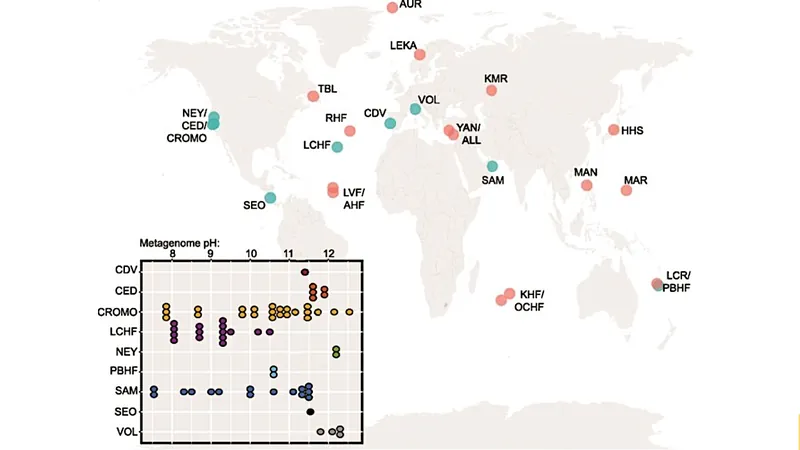
Unveiling the Secrets of Microbial Life in Serpentinites: Could These Hidden Communities Hold the Key to Alien Life?
2025-04-09
Author: Nur
The Fascinating Process of Serpentinization
Serpentinization may sound like a geological term reserved for textbooks, but it holds extraordinary implications for the origin of life on Earth and potentially on other planets, including our own solar system's moons. This fascinating process involves a series of geochemical reactions initiated by the hydration of ultramafic rocks and has been a fundamental part of Earth’s history.
These reactions create unique conditions that can support organic synthesis—think of it as a chemical cauldron conducive to life. However, they also generate fluids that pose significant challenges for living organisms due to very high alkalinity and an inadequate supply of inorganic carbon and oxidants. This duality makes serpentinite-hosted ecosystems incredibly interesting, as they may provide a glimpse into the origins of life, the limits of habitability, and the possibilities of extraterrestrial life.
The Discovery of Microbial Communities
Surprisingly, the thriving microbial communities within these serpentinite environments were only recognized in the last two decades, following the landmark discovery of deep-sea hydrothermal vents spewing serpentinized fluids. These vents are like underwater geysers, teeming with life that thrives in what would traditionally be considered harsh conditions.
Metagenomic Insights into Microbial Ecology
A closer examination of microbial ecology in these serpentinites—both in the ocean and on land—can be analyzed through the lens of metagenomic data. By synthesizing observations from various global ecosystems, we uncover remarkable consistency in the diversity and function of these microbial communities. Each unique system, however, presents its own peculiarities influenced by local geological characteristics, water chemistry, and the influence of oxidized fluids from the surface or seawater.
The Search for Answers
But significant questions remain. How does carbon source itself to support the biomass within these environments? What are the absolute extremes of life in these serpentinites? How does evolution play out in situ, and can modern serpentinites be used as analogs for understanding prehistoric Earth?
Implications for Astrobiology
These inquiries are critical in the search for life beyond our planet. The microbial ecology found in serpentinite environments not only broadens our understanding of life's resilience but also propels astrobiology into new territories of exploration. As we dive deeper into this remarkable field, each discovery has the potential to rewrite what we know about life—and challenge our imagination regarding where else it might exist.
Get ready, because we’re just scratching the surface of these astonishing ecosystems! Future research could unlock secrets that may very well change our perceptions of life in the universe. Stay tuned for more groundbreaking revelations from the hidden worlds of serpentinites!

 Brasil (PT)
Brasil (PT)
 Canada (EN)
Canada (EN)
 Chile (ES)
Chile (ES)
 Česko (CS)
Česko (CS)
 대한민국 (KO)
대한민국 (KO)
 España (ES)
España (ES)
 France (FR)
France (FR)
 Hong Kong (EN)
Hong Kong (EN)
 Italia (IT)
Italia (IT)
 日本 (JA)
日本 (JA)
 Magyarország (HU)
Magyarország (HU)
 Norge (NO)
Norge (NO)
 Polska (PL)
Polska (PL)
 Schweiz (DE)
Schweiz (DE)
 Singapore (EN)
Singapore (EN)
 Sverige (SV)
Sverige (SV)
 Suomi (FI)
Suomi (FI)
 Türkiye (TR)
Türkiye (TR)
 الإمارات العربية المتحدة (AR)
الإمارات العربية المتحدة (AR)